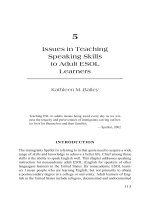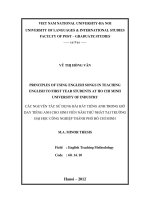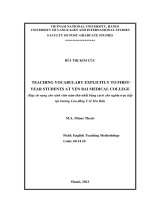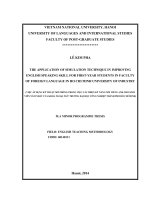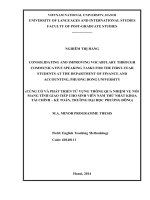The application of instructional strategies in teaching speaking english to first – year students in the college of urban works construction
Bạn đang xem bản rút gọn của tài liệu. Xem và tải ngay bản đầy đủ của tài liệu tại đây (1.36 MB, 10 trang )
The application of instructional strategies in
teaching speaking english to first – year students
in the college of urban works construction
Nguyễn Thị Hồng Anh
Trường Đại học Ngoại Ngữ
Luận văn ThS. Chuyên ngành: Methodology; Mã Số: 60 14 10
Người hướng dẫn: Pham Minh Hien, M.A
Năm bảo vệ: 2011
Abstract: This minor thesis aims at describing the application of instructional strategies in
teaching speaking English to first – year students in the College of Urban Works Construction.
The study is hoped to reveal the real situation of learning and teaching speaking English in a
general college. As a result of this, some effective instructional strategies can be chosen to
applied to better the students’ speaking English ability. In order to reach the goal, 70 first - year
students and 7 teachers of English were invited to finish survey questionnaires After that, all the
questionnaire data were analyzed. The findings expresses that direct and interactive instructions
are the major strategies applied in the speaking classes. Some advantages and disadvantages of
this application were discussed in details and thanks to this discussion and teachers’ suggestions,
various solutions were mentioned in the study with the hope to help teachers enhance their
teaching speaking quality and support students to better their oral exam results.
Keywords: Kỹ năng nói; Phương pháp dạy học; Tiếng Anh; Sinh viên
Content:
4
TABLE OF CONTENTS
STATEMENT OF AUTHORSHIP
ACKOWLEDGEMENTS
ABSTRACT
TABLE OF CONTENTS
LIST OF ABBREVIATIONS
LIST OF FIGURES, CHARTS AND APPENDICES …………………………….
Part A: INTRODUCTION…………………………………………………………
1. Rationales for the study………………………………………………………… …
2. Aims of the study………………………………………………… ………………
3. Scope of the study…………………………………………………………………
4. Methods of the study………………………………………………………… …….
5. Research questions…………………………………………………………… …
6. Significance of the study……………………………………………………………
7. Design of the study…………………………………………………………… …
Part B: DEVELOPMENT……………………………………………….…………
Chapter 1. Literature review…………………………………………………………
1. Current trends in teaching English as a second language…………………………
2. Communicative approach……………… ………………………………………….
3. Instructional strategies………………………………………………… ………….
3.1. History………………………………………… ……………………………
3.2. Categories……………………………………………… …………………
3.2.1. Direct Instruction……………………………………………… ………
3.2.2. Indirect Instruction……………………………………………… ……
3.2.3. Interactive Instruction………………………………… ………………
3.2.4. Experiential learning……………………… ………………………….
3.2.5. Independent study………… ……………
Chapter 2. The study…………………………………………………………………
1. An overview of the current situation of teaching and learning speaking at CUWC
I
ii
iii
iv
vi
vii
1
1
1
2
3
3
3
4
5
5
5
7
8
8
9
10
11
12
13
14
16
16
5
1.1. Syllabus and textbook ………………………………………………………
1.2. Learning and teaching condition …………………………… ……………….
1.3. Learners……………………………………………………………………….
1.4. Teachers……………………………………………………………………….
2. The study……………………………………… …………………………………
2.1. Informants……………………………………………………… ……………
2.2. Data collection instruments……………………………………………………
2.2.1. Questionnaires………………… ……………………………………….
2.2.2. Class observation ………………………………………………………
2.2.3. Interview………………………………………………………………
2.3. Data analysis and discussion of the findings…………… ……………………
2.3.1. Data analysis…………………………………………………………….
2.3.2. Discussion of the findings………………………………………………
2.3.2.1. The advantages of applying instructional strategies in teaching
speaking English …………………………………………………………………
2.3.2.2. The difficulties of applying instructional strategies in teaching
speaking English …………………………………………………………………
Chapter 3. Suggested solutions
1. Learning condition improvement …………………………………………………
2. Discipline maintenance……………………………………………… …
3. Engaged learning time increasing………………………………………………….
4. Provision for individual differences……………………………………… ……….
5. Evaluation of learning…………………………………… ……………………….
6. Some suggested speaking activities for large classes……………………………….
6.1. Topic brainstorming……………………………… ………
6.2. Tell a long story……………………………………………………… ……
6.3. Make presentation on certain topics…………………………………………
Part C: CONCLUSION ……………….……………………………………………
1. Summary of the study……………………………………………………………
2. Limitations of the study……………………………………………………………
16
16
17
18
19
19
19
19
19
20
20
20
23
23
26
28
28
29
32
34
35
36
36
37
38
39
39
40
6
3. Suggestions for further research
REFERENCES…………………………………………………………………
40
9
PART A. INTRODUCTION
1. Rationales
Teaching English is never an easy job, especially when we have to work with non-
major learners. There are a lot of reasons for this fact. One of them is that learners
have not realised the important role of English in their present study and future job.
The second is that English is always a really difficult subject with very challenging
tasks and requirements. Therefore, it is necessary to find out a way to make this
subject more interesting. Instructional strategies can work in this case.
With the development of Vietnam economy and society and the need of integration
with the modern world, the role of English is clear out. Following with this change,
there is the need for high – quality teachers with good and creative teaching methods
which can stop boring lessons and can attract learners. In other words, instructional
strategies are the first step to set up teachers’ qualities.
Teachers do not teach what they want but what students want and society wants.
Instructional strategies can help teachers be closer to students’ needs. They can base
and focus on learners’ knowledge and experiences. Teachers can base on students’
real life to set up their cirriculum and teaching plans and activities. Therefore,
instructional strategies are the brigde to connect teaching and learning with the fact.
For all the reasons above, instructional strategies are deserved to study and explored.
Hopefully, they can provide teachers with one more solution in their difficult job.
2. Aims and objectives of the study
Within the frame work of a minor thesis, the study is aimed at describing the
situation of applying instructional strategies in learning and teaching speaking in the
College of Urban Works Construction (CUWC) and suggesting some solutions to
the improvement of teaching speaking skill to students.
In order to achieve this aim, the study concentrates on:
10
- Investigating the current situation of the teaching and learning speaking skills
at CUWC.
- Identify the advantages and difficulties that the teachers and students face
while applying instructional strategies in teaching and learning speaking
skills
- Suggesting some solutions to help improve the application of instructional
strategies in teaching speaking skill.
3. Scope of the study
Because of limited time and experience, the study cannot investigate deeply all
problems and solutions while applying strategies in speaking skill in CUWC. It only
stops at describing some significant problems and suggesting some appropriate ways
to improve the application of these strategies in teaching speaking for students in the
college.
Owing to the reason mentioned above, the study does not cover all solutions to other
skills and levels as well as to exploit textbook of all kinds. It only focuses on New-
headway elementary textbook and ways to exploit it in teaching speaking skill.
4. Methods of the study
The study is designed to use both quantitative and qualitative methods. Besides,
various resources such as books, magazines, articles, newspapers and some
sources on the Internet have been chosen.
In order to gain the most successful results, the quantitative data will be collected
through two survey questionnaires. One survey questionnaire is for 85 non- major
first – year students of elementary level at CUWC and the other is for 6 teachers of
English in the Department of Basic Science. Collected data, then will be processed
and analyses to yield conclusions about the study.
11
Together the quantitative method, the qualitative data has been obtained by
informal interviews with some students and teachers to gather in-depth
information about the real situations of teaching and learning speaking skills at
CUWC. Besides, the author’s own observations will contribute much to the
completion of the study.
5. Research questions
The study is aimed at to answer three main questions:
a. What are the advantages of instructional strategies in teaching speaking skill?
b. What are the difficulties when applying these strategies in teaching skill for
non-major students?
c. How to apply instructional strategies effectively in teaching speaking skill ?
6. Significance of the study
It is hoped that this study will be a good source reference for both teachers and
learners of English. It is conducted to provide an insight into the current situation
of teaching English as a second language at CUWC and offer feasible solutions to
its improvement. Therefore, it is believed that this study will raise the teachers’
awareness of the advantages of techniques and activities in teaching speaking
skills so that they can adjust properly in order to develop students’ speaking skill.
7. Design of the study
The study is divided into three parts:
The first part “ Introduction” mentions the rationale, the aims, the scope, the
methods, the research questions, significance and the design of the study.
Next is the second part named “ Development” which consists of three chapters:
12
- Chapter 1 presents a thorough literature review relevant to the study. It
demonstrates the theorical background: the history of instructional strategies
and all related categories.
- Chapter 2 offers the methodologies performed in the thesis. It describes the
current situation of applying instructional strategies in teaching speaking skill
in CUWC. Besides, this chapter also includes the analysis of data collected
and the discussion of all findings.
- Chapter 3 proposes some solutions to the improvement of instructional
strategy application at CUWC.
Last but not least, the “Conclusion” gives a brief description of the study and
states the limitations as well as recommendations for further research.
49
REFERENCES
Ann, G. (1993). Communicative language teaching: An introduction and sample
activities. Office of Educational Research and Improvement, U.S. Dept. of
Education
Davies, P. (2000). Success in English teaching. Oxford University Press.
Dewey, J. (1997). Experience and Educator. Macmillan
Edurne, S. (2008). The different options in learning a language. Online Magazine
and Writer’s network.
Eric, K . ( 2008). How to teach speaking. Kaizen Publishing Inc.
Grace , S. B. (1998).Modules for the professional preparation of teaching
assistants in foreign languages . Washington, DC: Center for Applied Linguistics.
Hedge, T. (2000). Teaching and learning in the language classroom. Oxford
University Press
Henning, G. (1987). A guide to language teaching. Cambridge: Newbury House
Publishers.
Jack, C. R. (2006). Current trends in teaching listening and speaking. Oxford
University Press
Jack, C. R. ( 2006). Communicative language teaching today. Cambridge
University Press.
John, E. J. ( 1979). Handbook of structured experiences for human relation
training. Pfeiffer Company.
Joyce, B and Weil, M (1972). Models of teaching. Englewood Cliffs, NJ: Prentice-
Hall.
Margie, S. B. (1984). Teaching language: methods and materials. Office of
Educational Research and Improvement, U.S. Dept. of Education
50
Mc Neil and Wiles. ( 1990). The essentials of teaching : Decisions, plans,
methods. Macmillan.
NRC. ( 1999). How people learn. National Research Council.
Richard, I. A. ( 1993). Instructional strategies. The Gale Group.
Seaman and Fellenze. ( 1989). Effective strategies for teaching adults. Merrill
Pub. Co


